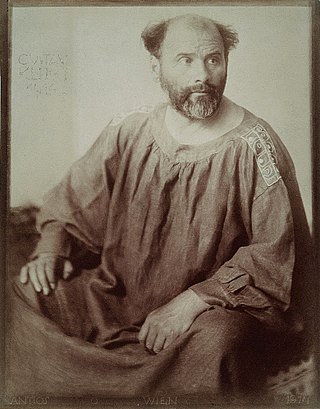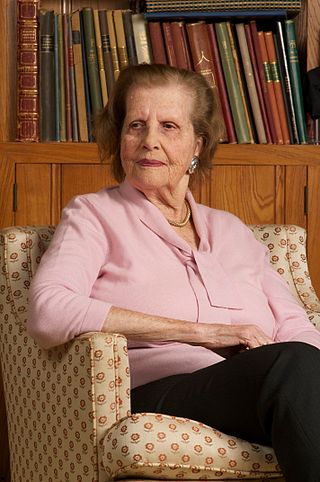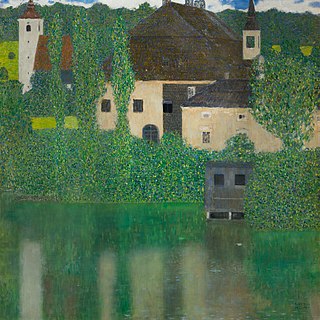
Gustav Klimt was an Austrian symbolist painter and one of the most prominent members of the Vienna Secession movement. Klimt is noted for his paintings, murals, sketches, and other objets d'art. Klimt's primary subject was the female body, and his works are marked by a frank eroticism. Amongst his figurative works, which include allegories and portraits, he painted landscapes. Among the artists of the Vienna Secession, Klimt was the most influenced by Japanese art and its methods.

Egon Leo Adolf Ludwig Schiele was an Austrian Expressionist painter. His work is noted for its intensity and its raw sexuality, and for the many self-portraits the artist produced, including nude self-portraits. The twisted body shapes and the expressive line that characterize Schiele's paintings and drawings mark the artist as an early exponent of Expressionism. Gustav Klimt, a figurative painter of the early 20th century, was a mentor to Schiele.

Oskar Kokoschka was an Austrian artist, poet, playwright, and teacher best known for his intense expressionistic portraits and landscapes, as well as his theories on vision that influenced the Viennese Expressionist movement.

The Kunsthistorisches Museum Wien is an art museum in Vienna, Austria. Housed in its festive palatial building on the Vienna Ring Road, it is crowned with an octagonal dome. The term Kunsthistorisches Museum applies to both the institution and the main building. It is the largest art museum in the country and one of the most important museums worldwide.

The Neue Galerie New York is a museum of early twentieth-century German and Austrian art and design located in the William Starr Miller House at 86th Street and Fifth Avenue in New York City. Established in 2001, it is one of the most recent additions to New York City's famed Museum Mile, which runs from 83rd to 105th streets on Fifth Avenue in the Upper East Side of Manhattan.

The Vienna Secession is an art movement, closely related to Art Nouveau, that was formed in 1897 by a group of Austrian painters, graphic artists, sculptors and architects, including Josef Hoffman, Koloman Moser, Otto Wagner and Gustav Klimt. They resigned from the Association of Austrian Artists in protest against its support for more traditional artistic styles. Their most influential architectural work was the Secession exhibitions hall designed by Joseph Maria Olbrich as a venue for expositions of the group. Their official magazine was called Ver Sacrum, which published highly stylised and influential works of graphic art. In 1905 the group itself split, when some of the most prominent members, including Klimt, Wagner, and Hoffmann, resigned in a dispute over priorities, but it continued to function, and still functions today, from its headquarters in the Secession Building. In its current form, the Secession exhibition gallery is independently led and managed by artists.

The Österreichische Galerie Belvedere is a museum housed in the Belvedere palace, in Vienna, Austria.

The National Gallery Prague, formerly the National Gallery in Prague, is a state-owned art gallery in Prague, which manages the largest collection of art in the Czech Republic and presents masterpieces of Czech and international fine art in permanent and temporary exhibitions. The collections of the gallery are not housed in a single building, but are presented in a number of historic structures within the city of Prague, as well as other places. The largest of the gallery sites is the Trade Fair Palace, which houses the National Gallery's collection of modern art. Other important exhibition spaces are located in the Convent of St Agnes of Bohemia, the Kinský Palace, the Salm Palace, the Schwarzenberg Palace, the Sternberg Palace, and the Wallenstein Riding School. Founded in 1796, it is one of the world's oldest public art galleries and one of the largest museums in Central Europe.

Maria Altmann was an Austrian-American Jewish refugee from Austria, who fled her home country after it was annexed to the Nazi’s Third Reich. She is noted for her ultimately successful legal campaign to reclaim from the Government of Austria five family-owned paintings by the artist Gustav Klimt that were stolen by the Nazis during World War II.

The Leopold Museum, housed in the Museumsquartier in Vienna, Austria, is home to one of the largest collections of modern Austrian art, featuring artists such as Egon Schiele, Gustav Klimt, Oskar Kokoschka, and Richard Gerstl.

The Kiss is an oil-on-canvas painting with added gold leaf, silver and platinum by the Austrian Symbolist painter Gustav Klimt. It was painted at some point in 1907 and 1908, during the height of what scholars call his "Golden Period". It was exhibited in 1908 under the title Liebespaar as stated in the catalogue of the exhibition. The painting depicts a couple embracing each other, their bodies entwined in elaborate robes decorated in a style influenced by the contemporary Art Nouveau style and the organic forms of the earlier Arts and Crafts movement.

Portrait of Adele Bloch-Bauer I is an oil painting on canvas, with gold leaf, by Gustav Klimt, completed between 1903 and 1907. The portrait was commissioned by the sitter's husband, Ferdinand Bloch-Bauer, a Viennese and Jewish banker and sugar producer. The painting was stolen by the Nazis in 1941 and displayed at the Österreichische Galerie Belvedere. The portrait is the final and most fully representative work of Klimt's golden phase. It was the first of two depictions of Adele by Klimt—the second was completed in 1912; these were two of several works by the artist that the family owned.

Death and Life is an oil-on-canvas painting by Austrian painter Gustav Klimt. The painting was started in 1908 and completed in 1915. It depicts an allegorical subject in an Art Nouveau (Modern) style. The painting measures 178 by 198 centimeters and is now housed at the Leopold Museum in Vienna.
Hope I is an oil painting created by Gustav Klimt in 1903. It is 189 cm x 67 cm and currently located in the National Gallery of Canada, Ottawa. The main subject of this work is a pregnant, nude female. She is holding her hands together above her stomach and close to her chest. She gazes directly at the viewer and has a great mass of hair with a crown of forget-me-not flowers placed on her head. The scene is beautiful upon first glance but once the viewer's eyes move to the background, deathlike figures become noticeably present.

Portrait of a Lady is an oil on canvas painting by Gustav Klimt, painted between 1916 and 1917. The painting measures 60 by 55 centimetres. It depicts a portrait of a female figure, composed in an unusually lively expressionistic style. It was acquired by the Galleria Ricci-Oddi in Piacenza in 1925.

Jan Mikulka is a Czech painter. He is known for his still-life painting and figurative and portrait work. In 2011 he won the Visitors's Choice BP Portrait Award in the National Portrait Gallery competition. He has twice succeeded in the international competition announced by the Royal Society of Portrait Painters in London, a showcase of contemporary portraiture. In 2013, he won the first prize for a self-portrait, and in 2016 The Changing Faces Prize, also awarded by the Royal Society of Portrait Painters.

Seated Woman with Bent Knees is a 1917 painting in gouache, watercolor, and black crayon on paper by the Austrian Expressionist artist Egon Schiele.

Lady with a Fan was the final portrait created by the Austrian painter Gustav Klimt. Painted in 1917, the uncommissioned piece depicting an unidentified woman was on an easel in his studio when he died in 1918. Like many of Klimt's late works, it incorporates strong Asian influences including many Chinese motifs.

Bruno Beran was a Czech academic painter.

Schloss by the Water or Schloss Kammer on the Attersee I is a 1908 oil on canvas painting by Gustav Klimt now in the National Gallery Prague.



















